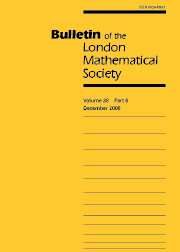Article contents
VANISHING THEOREMS FOR QUATERNIONIC COMPLEXES
Published online by Cambridge University Press: 01 May 1997
Abstract
1. Introduction
In 1978, Atiyah, Hitchin and Singer [1] introduced the twistor space as a ℙ1-fibration over a half-conformally flat 4-manifold, and thereby established a beautiful correspondence between Yang–Mills fields on 4-manifolds and holomorphic vector bundles on complex 3-folds. Hitchin gave the Penrose correspondence between solutions of anti-self-dual zero rest-mass field equations on a half-conformally flat manifold M and the sheaf cohomology groups H1(Z, F(k)), k[les ]−2, on its twistor space Z [4]. Here the holomorphic bundle F is the pull-back bundle of an anti-self-dual bundle over M, and we denote by [Oscr](−1) the tautological line bundle associated to the half-spin bundle. Hitchin further showed how H1(Z, F(−1)) corresponds to solutions of the self-dual Dirac equations, and interpreted H1(Z, F(k)), k[ges ]0, in terms of the cohomology of an elliptic complex on M.
Information
- Type
- Research Article
- Information
- Copyright
- © The London Mathematical Society 1997
- 7
- Cited by

